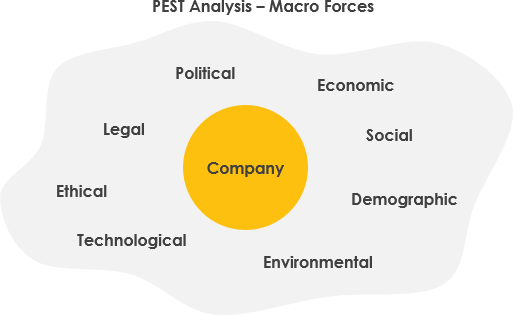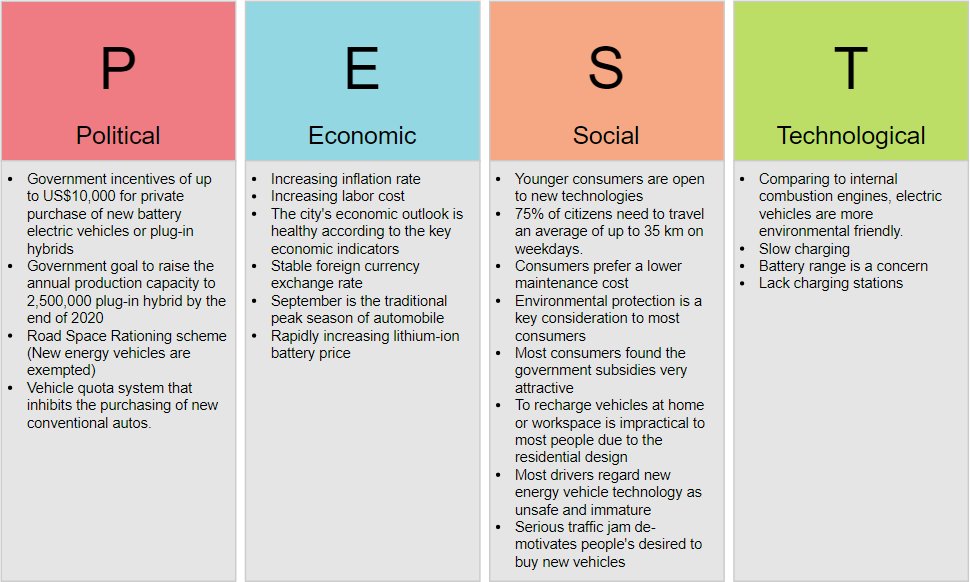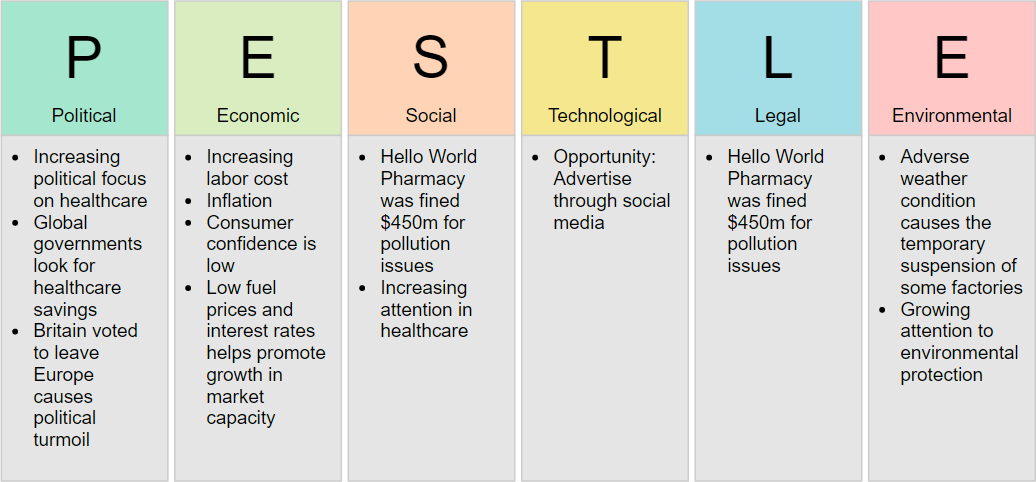The PEST analysis is a useful tool for understanding market growth or decline, and as such the position, potential and direction for a business. PEST is an acronym for Political, Economic, Social and Technological factors, which are used to assess the market for a business or organizational unit. Sometimes it's expanded to include legal and environmental factors and called a PESTLE analysis.

A PEST analysis guides us to identify effective strategies for setting priority, allocating resources, planning for time and development roadmap and formulating control mechanisms. With this analysis, you can identify potential opportunities and threats associated with your strategy and figure out ways to take advantage of them and avoid them.
These are all about how and to what degree a government intervenes in the economy. This can include - government policy, political stability or instability in overseas markets, foreign trade policy, tax policy, labour law, environmental law, trade restrictions and so on.
It is clear from the list above that political factors often have an impact on organisations and how they do business. Organisations need to be able to respond to the current and anticipated future legislation, and adjust their marketing policy accordingly.
Economic factors have a significant impact on how an organisation does business and also how profitable they are. Factors include - economic growth, interest rates, exchange rates, inflation, disposable income of consumers and businesses and so on.
These factors can be further broken down into macro-economical and micro-economical factors. Macro-economic factors deal with the management of demand in any given economy. Governments use interest rate control, taxation policy and government expenditure as their main mechanisms for managing macro-economic factors.
Micro-economic factors are all about the way people spend their incomes. This has a large impact on B2C organisations in particular.
We all know how fast the technological landscape changes and how this impacts the way we market our products. Technological factors affect marketing and the management thereof in three distinct ways:
Analyzing these factors will help you and your team gain a comprehensive understanding of the external (macro environmental) factors that may positively or negatively affect your company's strategic planning process. With access to such knowledge, you can quickly come up with strategies that would put the company on the fast track to achieving its goals.
A company may have all the information it requires about the quality of its infrastructure, the extent of funds, and the employee talent available to it, but it may not be fully aware of the external environment in which it is to operate or launch a new project. It can even predict future prospects of a project or product by studying the PEST factors. Let's list out the some benefits that we can gain from the findings of a PEST Analysis:
Let's take a moment to consider the impact that technology has had on our country's economy. Most people will agree that technology has made our lives much easier. The Internet, for example, has changed the way we bank, pay our bills, search for goods and services, book holidays, undertake study, and shop.
However, technology has caused serious damage to some businesses. In terms of casualties, the good old fashioned local CD & DVD rental store has taken a monumental hit. Why? Well, let's face it, there's now little need to visit a CD & DVD rental store. Today, most households have access to YouTube, Apple TV and Google Movies on Play Store and etc.
If a PEST analysis involves analyzing forces we have little or no control over, why bother considering them at all? To answer this question, a PEST analysis encourages management to carefully study what is happening in the environments that encapsulate their business.
As business managers we must understand that, although these external forces are largely outside of our control, we still need to carefully consider them. The underlying function of the analysis is not just to review what has already happened, but also predict what is likely to happen in the near future. This ensures we are aware of them and highly perceptive to their possible affects on our business.
The external influences on business vary from country to country. It is very important that those factors are considered. To conducting a PEST Analysis, we can come up a set of brainstorming questions with answers and actions of them related to each of the four factors:
The political arena has a huge influence upon the regulation of businesses, and the spending power of consumers and other businesses. You must consider issues such as:
The economic environment is a direct influence on all businesses. Obviously if you are studying marketing there is a huge element of economics within the topic itself, and you should be no stranger to the principles of economics. You need to look at:
The social and cultural influences on business vary from country to country. It is very important that such factors are considered. Factors to be considered include:
Technology is vital for competitive advantage, and is a major driver of globalization. Consider the following points:
Where you have identified significant opportunities, build the actions you'll take to exploit them into your Business Plan. Where you've identified significant risks, take appropriate action to manage or eliminate them.
The table below shows a PEST Analysis Template that consists of some typical kinds of factors people would consider in developing a PEST Analysis model.
| Political | Economic | Social | Technological |
|---|---|---|---|
|
|
|
|
Traditionally, PEST analysis focuses on political, economic, sociological and technological factors, but increasing awareness of the importance of legal, environmental and cultural factors has led to the evolution of a growing number of variants.

For example:
Choose the version that best suits your situation.
The figure below shows a PEST Analysis example of the new energy vehicles industry.

The figure below shows a PESTLE Analysis example of a pharmaceutical company. PESTLE is a varied form of PEST. It has two additional columns L and E for listing the Legal and Environmental factors.

PEST is useful before SWOT Analysis - not generally vice-versa - PEST definitely helps to identify SWOT factors. PEST Analysis is often linked with SWOT Analysis, however, the two tools have different areas of focus. There is overlap between PEST and SWOT, in that similar factors would appear in each. That said, PEST and SWOT are certainly two different perspectives: